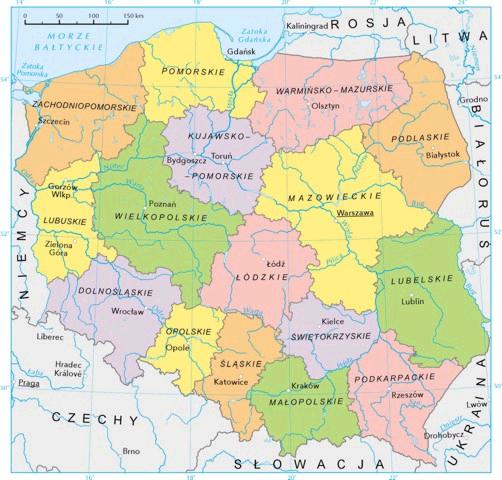Mazovia
 Provinces of Poland[1]
Provinces of Poland[1] |
Continuing up the Vistula River, the river turns east and enters into the next major geographical region, Mazovia. In the center of Mazovia is its provincial capitol, which is also the naional capitol, Warsaw.
Mazovia was very heavily settled by ethnic Germans and Dutch, most of whom were Mennonites, and then Catholic or Lutheran. Contrary to the previous two regions, most settlements in Mazovia were the result of population growth or government initiatives. Thus, most Mennonite settlements were in existing villages and had come from 'mother' congregations.
As in the previous pages, the information for this area is extracted mostly from the Mennonite Encyclopedia and the Dutch Settlement in Poland Project at www.holland.org.pl.
UNDER CONSTRUCTION
Into Mazovia (Mazowsze/ Mazowieckie)
It is very difficult to determine when the first members of the protestant Mennonite denomination (in earlier literature - Mennonist) appeared in Mazowsze. They arrived with the wave of Dutch settlers called Holenders (Holęder) or Olender (Olęder), who reached Mazowsze as early as the first half of the 17th century and established the Dutch settlements of Saska Kępa (1629) and Holendry Baranowskie (1645)[1] .
The Mennonites were undoubtedly at the forefront of the Dutch colonization in Polish lands; however, with time, they were outnumbered by the Lutheran colonists of primarily German origin. Based on the 19th century source materials, we can conclude that the vast majority of the Dutch that settled in Mazowsze belonged to the Lutheran congregation. However, it is difficult to determine the initial proportions of individual religious groups in this community. We know that many Mennonites who had initially settled in Mazowsze migrated further east and were replaced by Lutherans. In 1849, as a result of a tsar's ukase, which formed the Evangelical Consistory, the Mennonite settlements found themselves under the authority of the Lutheran parishes[6] . As a consequence, some Mennonites were formally and then actually incorporated into the Lutheran congregation. This process was also furthered by close co-existence of the members of both congregations, which began from the moment of settlement foundation, and religious placability of Mennonites. As a rule, members of this denomination did not engage in religious disputes believing that the most important is the adherence to the moral teachings of the Bible. Based on the records of church taxes paid in the 1830s and 40s by the Evangelical parishioners from Gąbin, we can assume that some of the Lutherans inhabiting villages on the Vistula riverbanks with Mennonite surnames, such as: Wedel, Ratzlaff, and Jantz, were of Mennonite descent [7] . . (Paweł Fijałkowski)
[Back to Schwetzer Neiderung] [Next to Deutsch-Wymyschle]
Sources
[1]. "provinces." pl-info.net.
Return To Histories Page
Return To Home Page
© 20011 Daniel Foote. Based on Template Designed by Andreas Viklund.